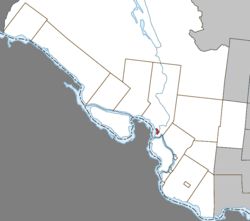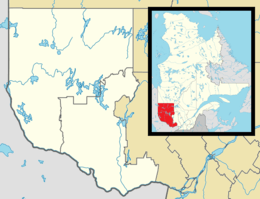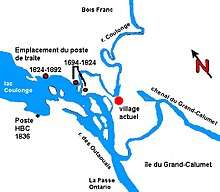Fort-Coulonge
Fort Coulonge is a village in the Pontiac Regional County Municipality in western Quebec, Canada, at the mouth of the Coulonge River. Its population in 2016 was 1,433. It is also the francophone centre of the otherwise largely (57%) anglophone Pontiac MRC, with 79.6% listing French as their mother tongue in the Canada 2006 Census.
Fort-Coulonge | |
|---|---|
Village municipality | |
Rue Principale in Fort-Coulonge | |
 Location within Pontiac RCM | |
 Fort-Coulonge Location in western Quebec | |
| Coordinates: 45°51′N 76°44′W[1] | |
| Country | Canada |
| Province | Quebec |
| Region | Outaouais |
| RCM | Pontiac |
| Constituted | December 15, 1888 |
| Government | |
| • Mayor | Gaston Allard |
| • Federal riding | Pontiac |
| • Prov. riding | Pontiac |
| Area | |
| • Total | 3.20 km2 (1.24 sq mi) |
| • Land | 3.10 km2 (1.20 sq mi) |
| Population (2016)[3] | |
| • Total | 1,433 |
| • Density | 462.4/km2 (1,198/sq mi) |
| • Pop 2011-2016 | |
| • Dwellings | 644 |
| Time zone | UTC−05:00 (EST) |
| • Summer (DST) | UTC−04:00 (EDT) |
| Postal code(s) | J0X 1V0 |
| Area code(s) | 819 |
| Website | www |
Fort-Coulonge is known for the Félix-Gabriel-Marchand Bridge, Quebec's longest covered bridge which is actually in neighbouring Mansfield-et-Pontefract.
Demographics
| Canada census – Fort-Coulonge community profile | |||
|---|---|---|---|
| 2016 | 2011 | 2006 | |
| Population: | 1,433 (4.1% from 2011) | 1,377 (+1.4% from 2006) | 1,358 (-18.2% from 2001) |
| Land area: | 3.10 km2 (1.20 sq mi) | 3.19 km2 (1.23 sq mi) | 3.19 km2 (1.23 sq mi) |
| Population density: | 462.4/km2 (1,198/sq mi) | 431.6/km2 (1,118/sq mi) | 425.7/km2 (1,103/sq mi) |
| Median age: | 46.2 (M: 45.8, F: 46.8) | 44.7 (M: 44.2, F: 45.1) | 42.6 (M: 42.4, F: 43.1) |
| Total private dwellings: | 644 | 601 | 676 |
| Median household income: | $49,408 | $35,329 | $39,007 |
| Notes: Includes corrections and updates for 2006. – References: 2016[3] 2011[4] 2006[5] earlier[6] | |||
| Year | Pop. | ±% |
|---|---|---|
| 1986 | 1,449 | — |
| 1991 | 1,647 | +13.7% |
| 1996 | 1,716 | +4.2% |
| 2001 | 1,661 | −3.2% |
| 2006 | 1,358 | −18.2% |
| 2011 | 1,377 | +1.4% |
| 2016 | 1,433 | +4.1% |
| Source: [7] | ||
History

In the late 17th century the site was occupied, perhaps intermittently, by members of the d'Ailleboust family, who used "sieur de Coulonge" as a title. Accounts differ: the Commission de toponymie du Québec mentions Nicholas d'Ailleboust de Manthet, who wintered in that location in 1694;[1] Elizabeth Browne Losey says it was founded by the d'Ailleboust family 'as early as 1650'.[8] With the fall of New France it was abandoned.
In 1784, the site was re-occupied when the North West Company built a fort, named Fort Coulonge.[1] When the Hudson's Bay Company took over in 1821 it continued to be supplied from Montreal. Until 1828 it was the head trading post on the Ottawa River. The post engaged in farming, as well as trading with the indigenous Ojibwe and Algonquins. After 1830, as the area became more settled, it became more like a general store. The post's 655-acre (2.65 km2) farm was sold in 1844. In 1855 the surviving store was sold to Thomas Taylor, its last clerk. The buildings were still standing in 1873 but by 1892 they had burned down.[8][9]
The trading post became the village of Fort-Coulonge situated several kilometres down river, when in 1843, the region's first sawmill was built by George Bryson Sr.. This was the impetus that led to permanent settlement and the formation of the village. Two year later in 1845, the mission of Saint-Pierre-de-Fort-Coulonge was established, followed by the Presbyterian parish of St. Andrews in 1863. Its post office opened in 1853.[1] By the mid 1860s, the town had a population of about 500.[9]
The first wooden chapel was built in 1873. It was destroyed by fire and replaced by a brick church in 1884. In 1886, the Pontiac Pacific Junction Railway reached Fort-Coulonge. Fort-Coulonge became a municipality in 1888 when it separated from the Township Municipality of Mansfield.[1] John Bryson, son of George Bryson, was the first mayor.[9]
The lumber industry continued to drive the growth of Fort-Coulonge in the 1890s and early 20th century. The many logging camps in the Ottawa Valley created a big demand for accommodation in the town; by the 1890s there were at least 5 hotels. The town's mills produced thousands of feet of cut lumber, as well as pulp wood.[9]
In passenger rail service to Fort-Coulonge ended in 1958, and cargo traffic ended in 1977.[9]
See also
- List of village municipalities in Quebec
- Coulonge Chutes
- Esprit Lodge - white water rafting training and certification.
- Cycloparc PPJ - former railway now converted into a bike path
References
- Reference number 23187 of the Commission de toponymie du Québec (in French)
- "Fort-Coulonge". Répertoire des municipalités (in French). Ministère des Affaires municipales, des Régions et de l'Occupation du territoire. Archived from the original on 2012-07-08. Retrieved 2012-04-02.
- "2016 Community Profiles". 2016 Canadian Census. Statistics Canada. February 21, 2017. Retrieved 2019-11-08.
- "2011 Community Profiles". 2011 Canadian Census. Statistics Canada. July 5, 2013. Retrieved 2014-01-28.
- "2006 Community Profiles". 2006 Canadian Census. Statistics Canada. March 30, 2011. Retrieved 2013-05-12.
- "2001 Community Profiles". 2001 Canadian Census. Statistics Canada. February 17, 2012.
- Statistics Canada: 1996, 2001, 2006, 2011 census
- Elizabeth Browne Losey, "Let Them be Remembered:The Story of the Fur Trade Forts", 1999.
- Dempsey, Gary T. (2018). Ottawa Valley Ancestry: A Dempsey Family History (5th ed.). Lulu.com. ISBN 9781387646890. Retrieved 8 November 2019.
External links
| Wikimedia Commons has media related to Fort-Coulonge. |